Uterine atony - Study guides, Class notes & Summaries
Looking for the best study guides, study notes and summaries about Uterine atony? On this page you'll find 2122 study documents about Uterine atony.
Page 4 out of 2.122 results
Sort by
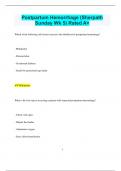
-
Postpartum Hemorrhage (Sherpath Sunday Wk 5) Rated A+
- Exam (elaborations) • 11 pages • 2024
-
Available in package deal
-
- $9.99
- + learn more
Postpartum Hemorrhage (Sherpath Sunday Wk 5) Rated A+ Which of the following risk factors increases the likelihood of postpartum hemorrhage? - Multiparity - Preterm labor - Gestational diabetes - Small-for-gestational-age infant Multiparity What is the first step in assessing a patient with suspected postpartum hemorrhage? - Check vital signs - Palpate the fundus - Administer oxygen - Start a blood transfusion 2 Palpate the fundus Which medication is commonly g...

-
Exam 3: Adaptive Quizzing Questions and Answers Already Passed
- Exam (elaborations) • 48 pages • 2023
- Available in package deal
-
- $14.49
- + learn more
The postpartum nurse has just received report on four clients. Which client should the nurse care for first? 1 Client who vaginally delivered a 7-lb baby 1 hour ago 2 Client who vaginally delivered a 9-lb baby 1 hour ago 3 Client who vaginally delivered a preterm baby 4 hours ago 4 Client who had a planned cesarean delivery of an 8-lb baby 2 hours ago - Correct Client who vaginally delivered a 9-lb baby 1 hour ago The nurse should assess the client at risk for postpartum hemorrhage first....
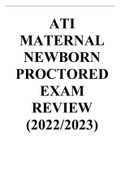
-
ATI MATERNAL NEWBORN PROCTORED EXAM REVIEW (2022-2023).
- Exam (elaborations) • 105 pages • 2022
-
Available in package deal
-
- $24.49
- 9x sold
- + learn more
ATI MATERNAL NEWBORN PROCTORED EXAM REVIEW (2022/2023) A nurse is caring for a client who is at 32 wks gestation and is experiencing preterm labor. What meds should the nurse plan to administer? a. misoprostol b. betamethasone c. poractant alfa d. methylergonovine Correct Answer: b. betamethasone A nurse at a prenatal clinic is caring for a client who suspects she may be pregnant and asks the nurse how the provider will confirm her pregnancy. The nurse should inform the client that what...
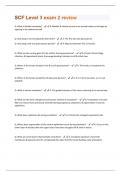
-
SCF Level 3 exam 2 review Questions and Answers 100% Verified
- Exam (elaborations) • 61 pages • 2024
- Available in package deal
-
- $7.99
- + learn more
Q: What is bladder exstrophy? - A: Bladder & related structure are turned inside out through an opening in the abdominal wall. Q: How long is mom bradycardic after birth? - A: The first two wks post-partum Q: How long is the true post-partum period? - A: May last between 9 & 12 months. Q: What are the nursing goals for the mother during puerperium? - A: Prevent hemorrhage, infection, & hypovolemic shock. Encourage bonding. Educate in self & infant care. Q: Where is the fundus located in th...
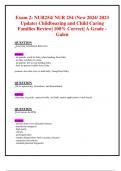
-
Exam 2: NUR254/ NUR 254 (New 2024/ 2023 Update) Childbearing and Child Caring Families Review| 100% Correct| A Grade - Galen
- Exam (elaborations) • 14 pages • 2024
-
Available in package deal
-
- $10.99
- + learn more
Exam 2: NUR254/ NUR 254 (New 2024/ 2023 Update) Childbearing and Child Caring Families Review| 100% Correct| A Grade - Galen QUESTION Assessing Attachment Behaviors - do parents reach for baby when handing them baby - do they call baby by name - do parents feel at ease holding baby - how do parents handle fussy baby promote skin-skin, how to hold baby, change/feed baby QUESTION NI for episiotomy, lacerations, and hemorrhoids Answer: cleansing, ice packs, squeez...
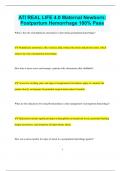
-
ATI REAL LIFE 4.0 Maternal Newborn: Postpartum Hemorrhage 100% Pass
- Exam (elaborations) • 10 pages • 2024
-
Available in package deal
-
- $9.99
- + learn more
ATI REAL LIFE 4.0 Maternal Newborn: Postpartum Hemorrhage 100% Pass What is the role of prophylactic uterotonics in preventing postpartum hemorrhage? Prophylactic uterotonics, like oxytocin, help contract the uterus and prevent atony, which reduces the risk of postpartum hemorrhage. How does a nurse assess and manage a patient with a hematoma after childbirth? Assess for swelling, pain, and signs of compromised circulation; apply ice, monitor the patient closely, and prepare for...
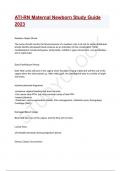
-
ATI-RN Maternal Newborn Study Guide 2023ATI-RN Maternal Newborn Study Guide 2023 Questions And Verified Solutions A+ Graded
- Exam (elaborations) • 87 pages • 2024
-
- $15.49
- + learn more
ATI-RN Maternal Newborn Study Guide 2023ATI-RN Maternal Newborn Study Guide 2023 Questions And Verified Solutions A+ Graded Newborn Septic Shock: The nurse should monitor the blood pressure of a newborn who is at risk for septic shock and should identify decreased blood pressure as an indication of this complication. Other manifestations include tachypnea, tachycardia, mottled or gray-colored skin, cool extremities, and a rapid pulse. Early PostPartum Period: Dark Red Lochia wil...
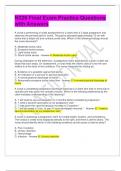
-
N326 Final Exam Practice Questions with Answers
- Exam (elaborations) • 24 pages • 2024
-
- $12.99
- + learn more
N326 Final Exam Practice Questions with Answers A nurse is performing a fundal assessment for a client who is 2 days postpartum and observes the perineal pad for lochia. The pad is saturated approximately 12 cm with lochia that is bright red and contains small clots. Which of the following findings should the nurse document? A. Moderate lochia rubra B. Excessive lochia serosa C. Light lochia rubra D. Scant lochia serosa - Answer-A. Moderate lochia rubra During ambulation to the bathr...
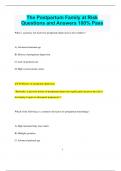
-
The Postpartum Family at Risk Questions and Answers 100% Pass
- Exam (elaborations) • 34 pages • 2024
-
- $10.49
- + learn more
The Postpartum Family at Risk Questions and Answers 100% Pass What is a primary risk factor for postpartum depression in new mothers? A) Advanced maternal age B) History of postpartum depression C) Lack of prenatal care D) High socioeconomic status B) History of postpartum depression *Rationale: A previous history of postpartum depression significantly increases the risk of developing it again in subsequent pregnancies.* Which of the following is a common risk factor for postp...

-
Maternity Practice Test PASSED Exam Questions and CORRECT Answers
- Exam (elaborations) • 23 pages • 2024
- Available in package deal
-
- $9.49
- + learn more
Maternity Practice Test PASSED Exam Questions and CORRECT Answers The perinatal nurse is caring for a woman in the immediate postbirth period. Assessment reveals that the woman isexperiencing profuse bleeding. The most likely etiology for the bleeding is: Select one: a. Uterine atony. b. Uterine inversion. c. Vaginal hematoma. d. Vaginal laceration. - Correct Answer- A

Do you wonder why so many students wear nice clothes, have money to spare and enjoy tons of free time? Well, they sell on Stuvia! Imagine your study notes being downloaded a dozen times for $15 each. Every. Single. Day. Discover all about earning on Stuvia


